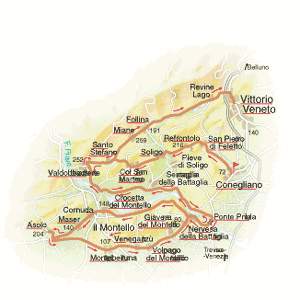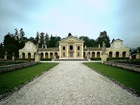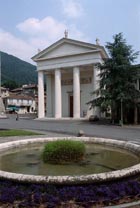The land of Prosecco
 Prosecco land occupies a wide swathe of hills cut through by the River Piave. The tour divides into two itineraries, one each side of the river. The first explores what’s called the “Strada del Vino Bianco” (White Wine Road), leaving from Conegliano and finishing at Vittorio Veneto; the second starts at the town of Valdobbiádene and crosses the Piave to wind through the Montello hills, an area famous for both its wines and its splendid villas.
Prosecco land occupies a wide swathe of hills cut through by the River Piave. The tour divides into two itineraries, one each side of the river. The first explores what’s called the “Strada del Vino Bianco” (White Wine Road), leaving from Conegliano and finishing at Vittorio Veneto; the second starts at the town of Valdobbiádene and crosses the Piave to wind through the Montello hills, an area famous for both its wines and its splendid villas.

Conegliano
Well known as the home of Prosecco, the highly regarded white wine produced in this area, the town stands at the foot of the hill on the left bank of the Piave river. The centre has grown in the lee of the castle, which was built before the year 1000 by the Bishops of Belluno and subsequently destroyed. Fought over by the various different baronal domains or seigniories in the centuries leading up to Venice taking over, the city has frequently shown enterprising productivity in modern times, by becoming the headquarters of large industries, in particular those of wine-making and electric household appliances. The cathedral, which was begun in the 14th c., is connected to the Scuola dei Battuti and its fine hall, and houses a number of important 15th- and 16th-c. paintings.
Vittorio Veneto
 A town in the Treviso area which presides over access from the west to the valleys of the Belluno area. It was created in the early years of the Kingdom of Italy by joining together two existing neighbourhoods, Serravalle and Ceneda, which had had very different histories. Serravalle was an important town in Roman times, Ceneda during the Longobard era. In the years that followed, both were subjects of Venice. Ceneda still has a cathedral which is 13th c. in origin. The Loggia del Cenedese, which would appear to have been designed by Sansovino, now houses the Museum of the Battle of Vittorio Veneto, the decisive event in the World War I. Serravalle still has a number of medieval buildings in its fine Piazza Flaminio, while along the Corso Calgrande are several 16th-c. and Venetian-style palaces.
A town in the Treviso area which presides over access from the west to the valleys of the Belluno area. It was created in the early years of the Kingdom of Italy by joining together two existing neighbourhoods, Serravalle and Ceneda, which had had very different histories. Serravalle was an important town in Roman times, Ceneda during the Longobard era. In the years that followed, both were subjects of Venice. Ceneda still has a cathedral which is 13th c. in origin. The Loggia del Cenedese, which would appear to have been designed by Sansovino, now houses the Museum of the Battle of Vittorio Veneto, the decisive event in the World War I. Serravalle still has a number of medieval buildings in its fine Piazza Flaminio, while along the Corso Calgrande are several 16th-c. and Venetian-style palaces.
Maser
 In a magnificent position with the hillside immediately behind it, the Villa Barbaro at Maser is universally acknowledged as one of Palladio’s masterpieces. The central block, presented to the visitor’s eye with the perspective of an open expanse of green, has a pediment supported by four columns, between which are sets of upstairs and downstairs windows. The wings, which are set further back, incorporate a spacious low open gallery with a high tympanum at each end. In 1560 Paolo Veronese painted an extensive cycle of grand frescoes.
In a magnificent position with the hillside immediately behind it, the Villa Barbaro at Maser is universally acknowledged as one of Palladio’s masterpieces. The central block, presented to the visitor’s eye with the perspective of an open expanse of green, has a pediment supported by four columns, between which are sets of upstairs and downstairs windows. The wings, which are set further back, incorporate a spacious low open gallery with a high tympanum at each end. In 1560 Paolo Veronese painted an extensive cycle of grand frescoes.
Montebelluna
This town in the Marca region stands at the foot of the Montello range of hills, halfway between Treviso and the Piave valley, and is renowned for its modern industrial activity, the manufacture of mountain boots. It sprang up around the Mons Bellonae, a hill on which a market was held in medieval times. Fortified and attached to the commune of Treviso, it came to be ruled by Venice towards the end of the 14th c. The modern industrial development of the town has caused rapid expansion and led to Montebelluna encompassing other built-up areas nearby.
Asolo
Small centre rich in history and culture situated among the Treviso Hills near Montebelluna. Perhaps on account of its particularly mild climate, it was already a centre of some importance – known as Acelum – in Roman times, with a theatre, thermal baths and its own aqueduct. In the centuries that followed, it was fortified and had a chequered history. It is worth visiting the Civic Museum, which, in addition to its large stock of archaeological material , has on show sculptures and paintings by Canova, Strozzi, Canaletto and other great artists from the collection of Caterina Cornaro, the Venetian-born queen of Cyprus and later the sovereign of Asolo.
Valdobbiadene
 Agricultural town, noted for its wine production, which stands on high ground in the Pre-Alps of the Belluno area on the left bank of the Piave river. It is one of the biggest centres in Italy for the production and marketing of naturally fermenting sparkling wines. The site was inhabited in very early times and during the Middle Ages was a staging-post for travellers heading into the Belluno area. It was completely destroyed in World War I.
Agricultural town, noted for its wine production, which stands on high ground in the Pre-Alps of the Belluno area on the left bank of the Piave river. It is one of the biggest centres in Italy for the production and marketing of naturally fermenting sparkling wines. The site was inhabited in very early times and during the Middle Ages was a staging-post for travellers heading into the Belluno area. It was completely destroyed in World War I.
|
THE PLEASURES OF THE TABLE |
|
| Marmellata di marroni di Combai | Zaleti |
| The chestnut trees in the hills between Valdobbiádene and Vittorio Veneto provide edible chestnuts of the highest quality, often used to make a type of chestnut jam (marmellata di marroni) by local firms. The village to gain most fame from the production of this very special jam is Combai, near Miane Valdobbiádene, whence the jam takes its name. | Zaleti, the most famous biscuits of the Veneto, are made with white and brown flour blended with sugar, sultanas and pine nuts. Excellent for dunking in sweet wine or in coffee. |
| Morlacco | |
| Morlacco is a typical Alpine summer-pasture cheese made with unpasteurised skimmed milk. The curd is left to set on a whicker base before a sprinkle of salt is added. Typically, morlacco has a straw yellow rind, a soft ivory-coloured inside with holes, and a slightly sour, rather salty taste. Eaten raw and not used in cooking. | |
|
THE WINE |
| Here in Trevigiano, particularly between the two villages of Valdobbiane and Conegliano, they cultivate the autoctono vine Prosecco, the origin of the most reknowned Spumanti in Italy: the Prosecco di Conegliano-Valdobbiadene, an amabile or sweet wine that achieves maximum expression in the territiory of San Pietro di Barbozza, where it takes the name Superiore di Cartizze. If you would like to prepare a lunch or dinner reminiscent of the area, click here to purchase wines carefully selected by our experts. |
|
EATING AND SLEEPING |
| On the road between Valdobbiadene and Vittorio Veneto we suggest you to stop in the village of Follina at the restaurant Al Caminetto (tel. +39 0438970402). Here you will be able to taste typical dishes from the region, like meat skewers cooked in the fireplace, or appetizers with "soppressa", mushrooms and "polenta". In the old town centre of Asolo, a good stop is the "enoteca" Ca' Derton (tel. +39 0423529648) located in an ancient building from the eighteenth century, where you will be able to taste a fantastic local selection of cheese, including the famous Morlacco, beside hot dishes like "bigoli" in duck sauce, roasted quails or the local "sopa coada". To sleep we suggest you the hotel Villa Abbazia in Follina (tel. +39 0438971277), located in a seventeenth century building, of great atmosphere and with very nice rooms. In Conegliano a good address is the Canon D'Oro (tel. +39 043834246) in a nice and old mansion. |








